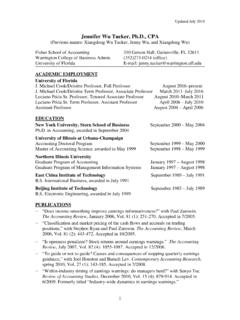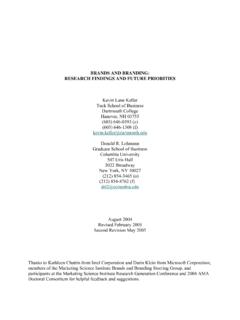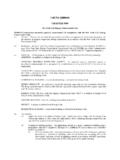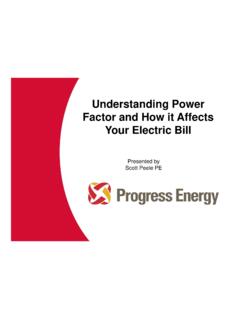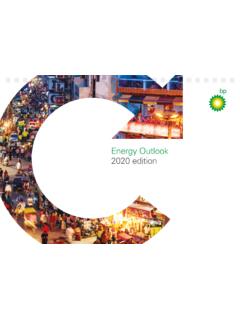Transcription of Renewable Energy in Developing and Developed Nations ...
1 University of Florida | Journal of Undergraduate Research | Volume 15, Issue 3 | Summer 2015 1 Renewable Energy in Developing and Developed Nations : Outlooks to 2040 Nicole Vandaele1 and Dr. Wendell Porter2 1 College of Agriculture and Life Sciences, University of Florida, 2 College of Agricultural and Biological Engineering, University of Florida With increasing concern over the environmental effects of burning fossil fuels, the call for a more sustainable resource base has never been louder. Both Developed and Developing Nations depend on an assortment of primary Energy sources to produce electricity, like coal, natural gas, biomass, oil and renewables.
2 This study addresses the problem of transitioning to a Renewable Energy -based electricity generating infrastructure. To do this, we explored the current and future state of Energy affairs in the United States and Developing countries of Kenya, Morocco and South Africa. From this research, we created a framework that can be applied to any country to determine the required capacity installations per year until 2040 in order to generate nearly 100% of electricity with Renewable sources. This framework utilizes estimates of future electricity consumption per capita to project total electricity demand in 2040.
3 From here, this demand is allocated to a variety of Renewable Energy generating sources. The framework was then applied to the four study countries, demonstrating how their potential capacity for Renewable technologies and Energy efficiency measures can transform their Energy sectors into more sustainable, diverse resource bases for electricity generation. INTRODUCTION Traditional, non- Renewable sources of electricity like coal, natural gas and oil, supply a vast majority of the world s electricity demand.
4 However, these sources are criticized for intense greenhouse gas emissions, availability concerns, economic feasibility uncertainties, and association with a dependence on foreign Energy supply (Hidayatullah et al., 2011). Renewable sources, like solar photovoltaic (PV), wind, hydroelectric, geothermal and biomass, are becoming attractive options because of their low carbon impact, indefinite supply, price stability in the Energy market and economic benefits.
5 However, renewables have shortcomings as well, like high initial costs, an intermittent Energy supply, and inability to supply a stable, base load electricity demand (Giraldo et al., 2014; Hidayatullah et al., 2011). Studies have shown that Energy availability and economic growth are inextricably linked (Neto et al., 2014). Ohler and Fetters (2014) contend that Renewable Energy technologies hold important roles in future Energy use and economic prosperity, and subsequently lead to a faster transition towards a Developed society.
6 The problem lies in the transition from fossil fuels to Renewable Energy sources for electricity generation. Therefore, this study aimed to create a universal framework that 1) outlines the required, capacity installations per year until 2040 to generate 100% of electricity demand through five Renewable Energy sources, and 2) can be applied to all countries, regardless of their stage of development, socioeconomic prosperity, and current state of Energy affairs.
7 We tested this framework with four countries of interest. The resulting provisional national Energy blueprints integrated current plans for capacity upgrades with potential Renewable Energy capacity, and harnessed them both to phase out coal, natural gas and oil for electricity generation completely. Working towards these types of idealized plans can create positive, incremental changes in how electricity is generated, even if the ultimate goal is not fully reached within the set time frame.
8 The information and conclusions offered in this study create only one path of many that individual countries can possibly take, and are encouraged to be expanded by individual perspectives and considerations. METHODOLOGY The study focused on Kenya, Kingdom of Morocco, the Republic of South Africa, and the United States of America. These countries were chosen because they reflect varying stages of economic development, current electricity generation situations, and potential for Renewable Energy technologies.
9 Statistics from 2012 regarding electricity production, consumption, imports, exports, and electricity access were compiled to provide a snapshot of each country s Energy situation. The year 2012 provided the most recent, complete data set for all four countries. Data was collected from publically available databanks like the International Energy Agency (IEA), Energy Information Administration (EIA), Central Intelligence Agency World Factbook, and the World Bank.
10 Then, various government reports and investment agency statements were examined to determine the potential for NICOLE VANDAELE AND DR. WENDELL PORTER University of Florida | Journal of Undergraduate Research | Volume 15, Issue 3 | Summer 2015 2 Renewable Energy capacity that each country established based on their geographic and geologic features. Finally, we examined peer-reviewed journal articles accessed through the University of Florida Libraries about current and upcoming Energy efficiency technologies.



